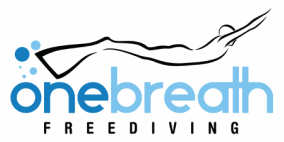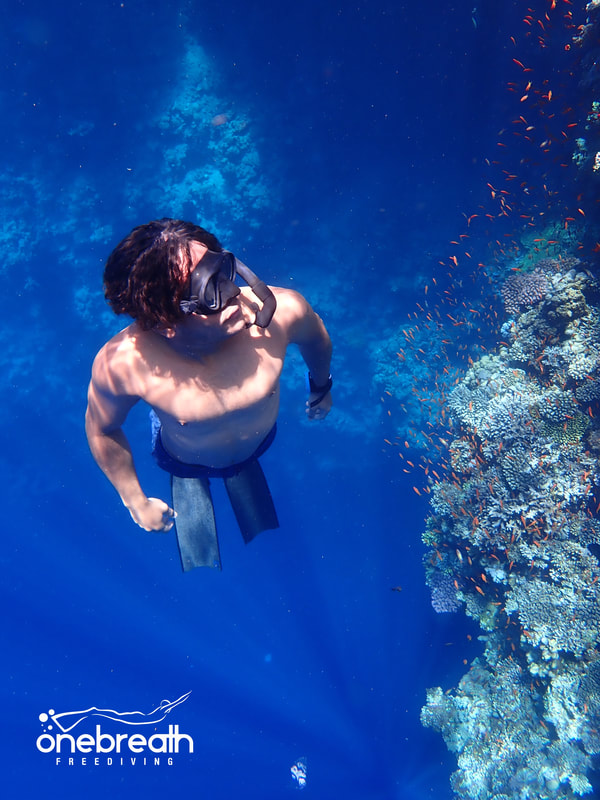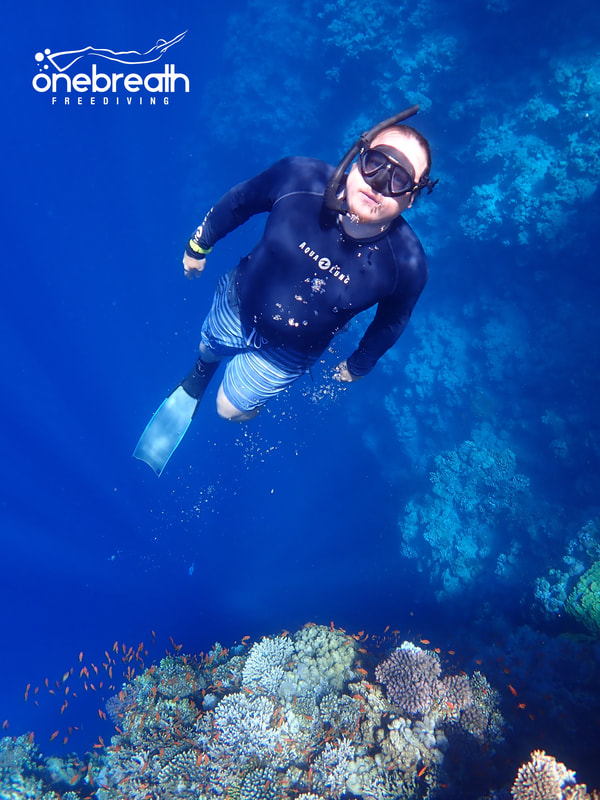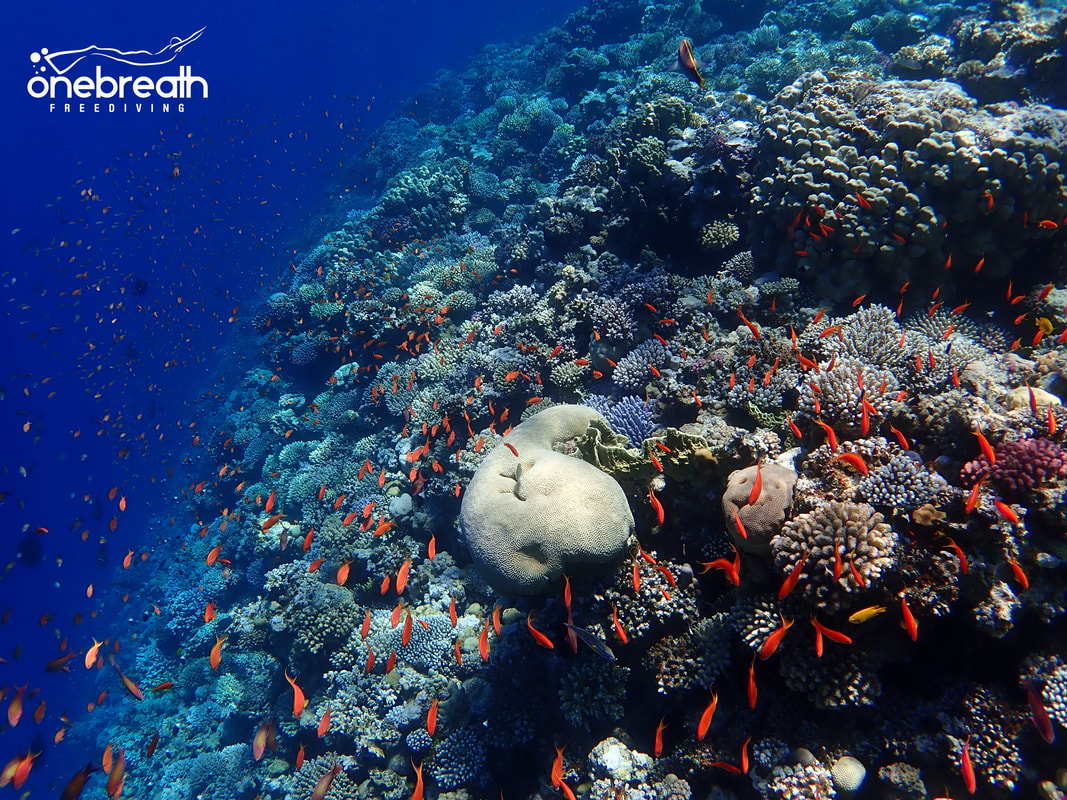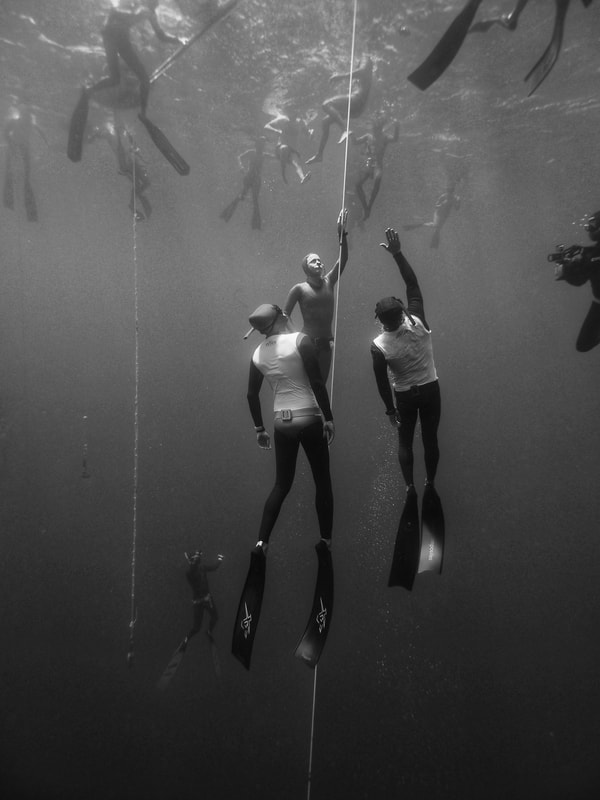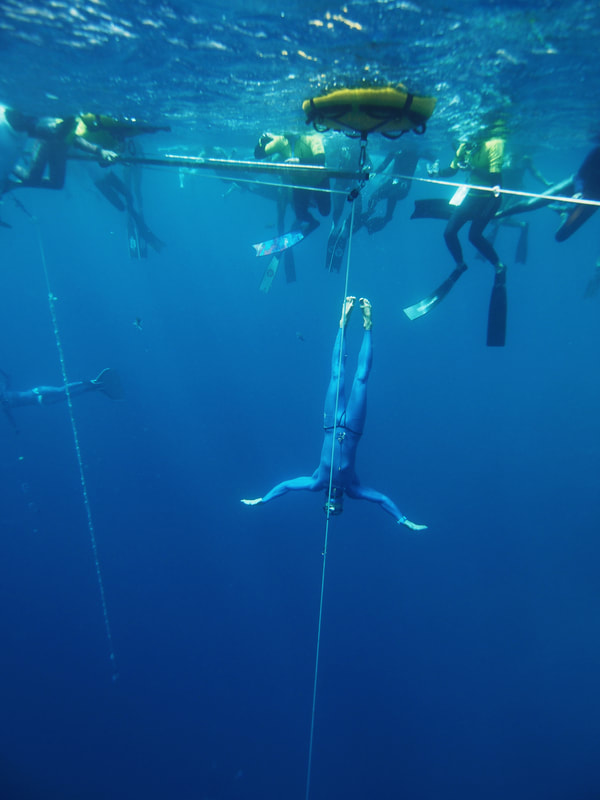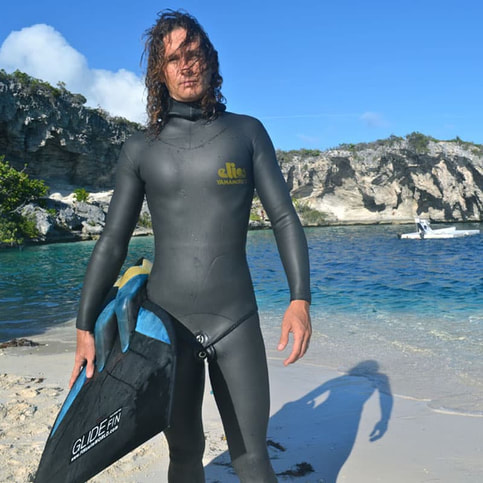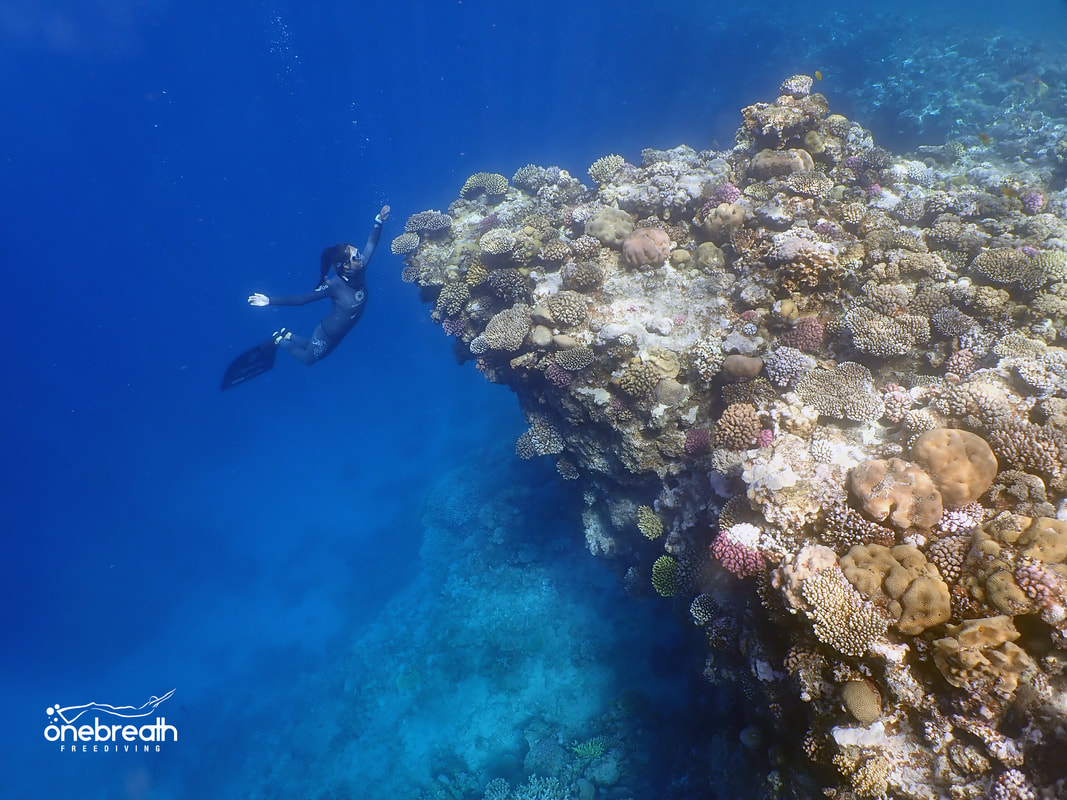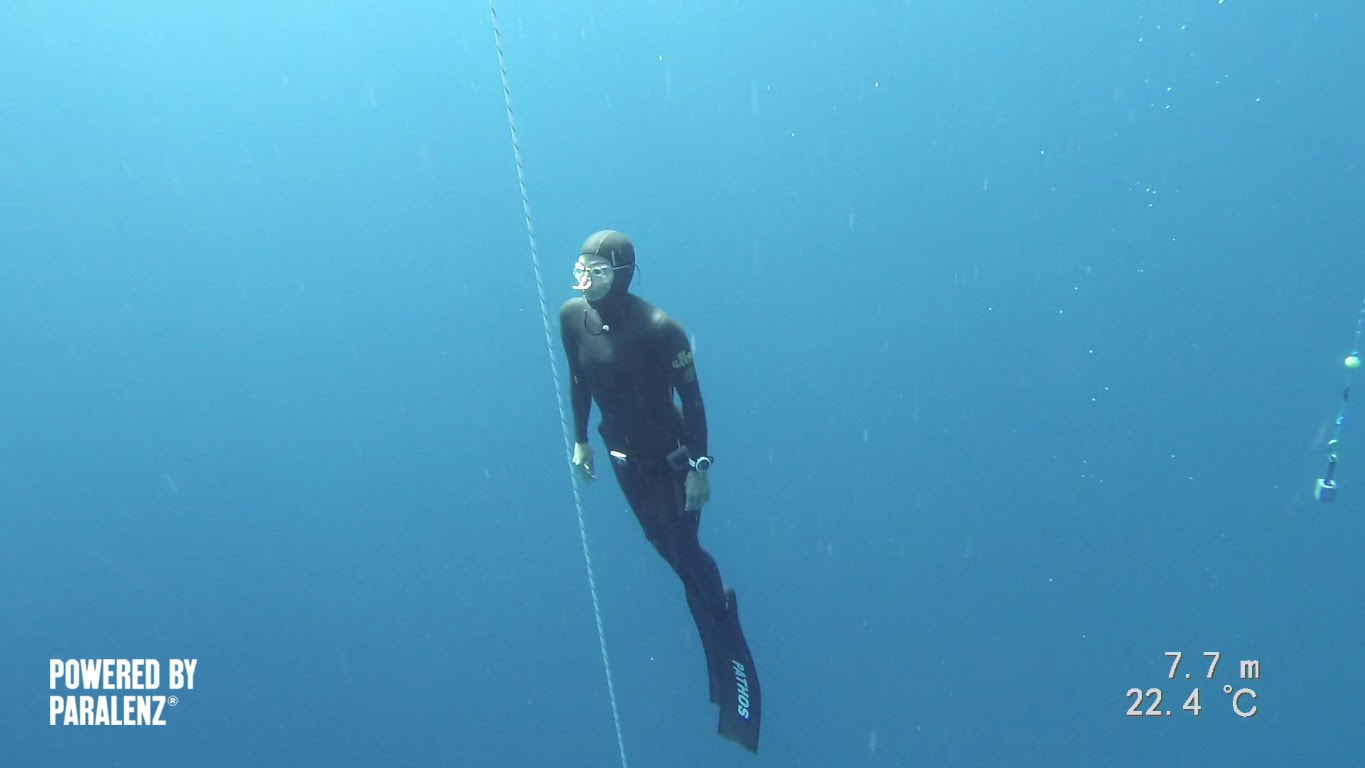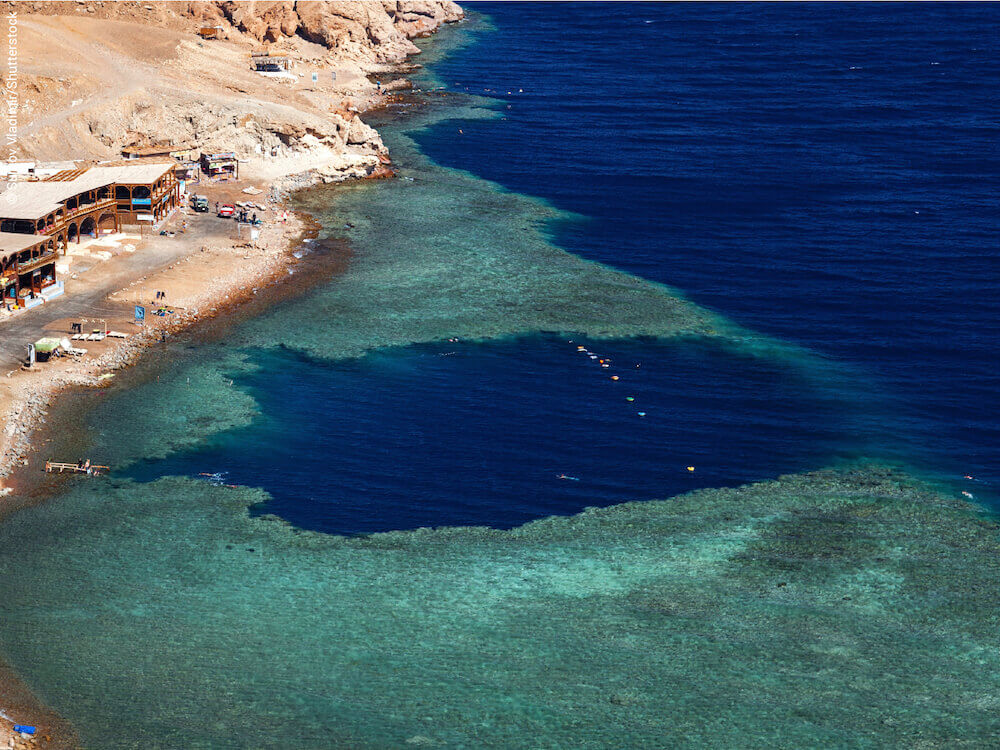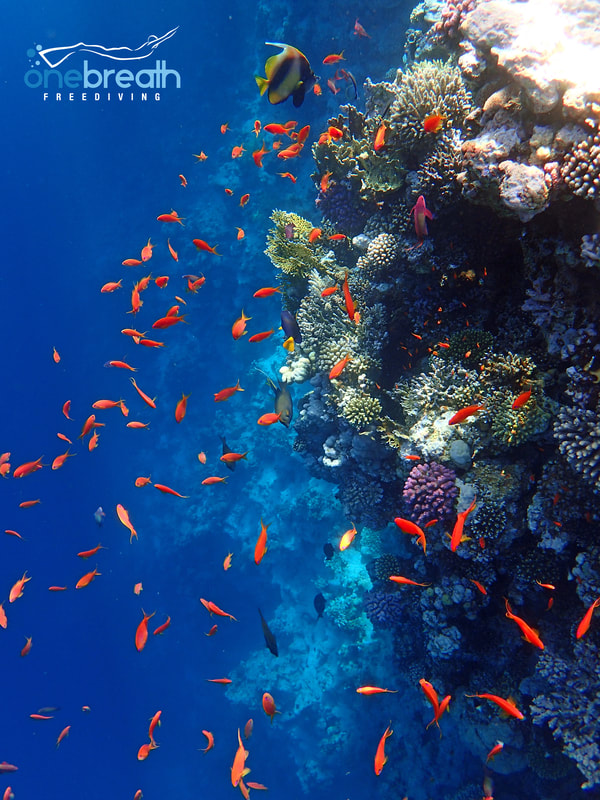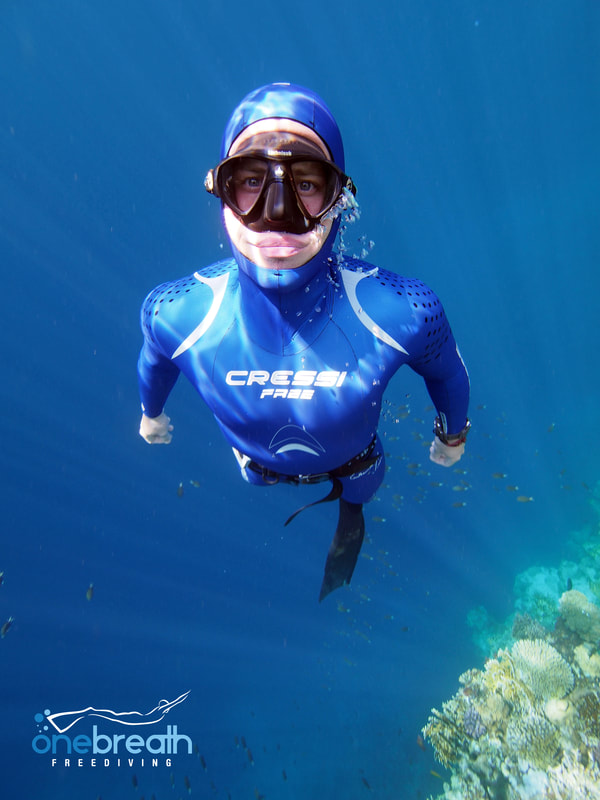|
The Blue Hole in Dahab has a stunning reef with vibrant colours. There is nothing better than after a tough training session on the buoy & line than enjoying the natural beauty of the reef with the freedom and simplicity without the wetsuit and feeling the water on your skin.
0 Comments
A couple of the best photos taken by myself at the recent Dahab Apnea 2021 competition at the Blue Hole. Congratulations to all the athletes and especially the overall winners:
Stefan Randig (1st Male) Alice Modolo (1st Female) And thanks to all the judges, safety divers and other volunteers :) New AIDA Variable Weight world record of 150m set by Walid Boudhiaf of Tunisia. See the video of the dive below and to view all the current AIDA freediving world records check out this link: www.freedivingrecords.com By David Watson, AIDA Instructor Trainer and Owner & Founder at One Breath Freediving Hello freedivers :) I recently had a few questions regarding wetsuits for freediving so I thought I would do a blog post to share a couple of my opinions and thoughts and also to direct you to a very useful guide to choosing your first freediving wetsuit. Here are 5 useful tips about freediving wetsuits that you might not know or have considered:
Guide to buying your first freediving wetsuit HERE
I hope this was helpful, let me know your thoughts on the topic! By David Watson, AIDA Instructor Trainer & PADI Master Freediver Instructor and Owner & Founder at One Breath Freediving “Time isn’t precious at all, because it is an illusion. What you perceive as precious is not time but the one point that is out of time: the Now. That is precious indeed. The more you are focused on time — past and future — the more you miss the Now, the most precious thing there is.”
Eckhart Tolle By David Watson, AIDA & PADI Master Freediver Instructor and Owner & Founder at One Breath Freediving, based in Malta. To keep you engaged and inspired during these times of uncertainty and adversity I have pulled together 10 of my favourite inspirational sporting quotes from athletes and coaches. Remember, there is always something you can train or work towards, even if you can’t get to the pool or sea right now. Use this time to work on mental toughness, pre-dive routine, breath hold training....there are still many options to improve yourself. I hope these quotes can help you on your way towards your goals.
Do you have another favourite sporting quote to share, maybe one that has really helped motivate or inspire you in the past. If so, add it to the comments below.
Ever wondered if there is a natural way to 'cheat' at freediving? This could be the answer! The studies seem to prove it. Watch the video to find out more.... By David Watson, AIDA & PADI Master Freediver Instructor and Owner & Founder at One Breath Freediving, based in Malta Dahab on the Red Sea Sinai coast of Egypt has long been home to a thriving freediving scene. Let’s look at ten good reasons you should visit as a freediver this winter! 1. Blue Hole: Visit the famous Blue Hole of Dahab which has 100m deep water just metres from the shore (see photo). Here you will find some of the world’s top freedivers training alongside the stunning scenery of the deep blue water and mountain back drop. 2. Tropical Water: The red sea is the closest tropical water to Europe and it is very different to the Mediterranean Sea with much more colours and corals. Here water temperatures range from 22c-30c, so even at its coldest in winter, it is still much warmer than the nearby Mediterranean at the same time of year. 3. Winter Sun: Dahab is lovely and sunny! While Northern Europe gets rain and darkness, Egypt is still a lovely 18c-28c which is perfect without feeling like it is too much. And being in a desert region there is virtually no rain. 4. Depth: Very easy access to depth for deeper freediving. The bay where Dahab sits is sheltered from any wind and gives depths of up to 50m just metres from the shore. For depths over 50m, the Blue Hole is just a short taxi ride away. And all with no thermoclines. 5. Social – Lots of Freedivers!: Dahab has to be one of, if not the only, place in the world where freedivers are not greatly outnumbered by scuba divers, and to talk to someone about freediving does not have to involve a long explanation about the sport (“No...... not cliff jumping”). 6. Chilled Out & Friendly Vibe:
Unlike the more touristy parts of Egypt or North Africa, Dahab has a slower and more relaxed vibe. There is less hassle and a much more relaxed atmosphere than many other parts of Egypt, such as Sherm el Sheikh. 7. ‘Finding Nemo’: Naturally, as the water is more tropical, so the marine life is more colourful and there are lots of colourful corals and fish to see. A favourite at recreational freediving depths are the numerous Anemone Fish (Nemo fish). If you are really luck the turtles in Dahab bay will come over to say hello. 8. Multi-Sports: Dahab has to be one of the few places in the world that is good for both freediving and kite surfing. With a prevailing wind from the North, the main dive sites remain sheltered while giving enough wind to make superb windsurfing and kite surfing conditions. Not to mention scuba diving, rock climbing, trekking....... 9. Bedouin Camp Hospitality: The Bedouins, the nomadic people of this region of the world, are extremely friendly and always offer wonderful hospitality. There is nothing better for an evening than sitting under the stars next to a camp fire with a cup of sweet Bedouin tea in your hand. 10. One Breath Freediving: In winter One Breath Freediving will be providing high quality and customised freediving training and courses from Dahab. Expect the same high standard just in a different location! So if you have seen Malta and want to experience somewhere different, this is definitely the place to go next. By David Watson, AIDA & PADI Master Freediver Instructor and Owner & Founder at One Breath Freediving, based in Malta
Recently, during a shallower freediving session (that was forced on to us due to bad weather), I was diving down to the sea floor and just lying still on the sandy bottom playing with the sand in my hands. It was here during these breath holds that I was reminded of the importance of fun for freediving training. So for this blog post I wanted to discuss the concept of fun in sport and the importance of making practice ‘fun’, and how this can apply to freediving. Freediving is a sport that can too often be overly focused on its end goals as a measure of success, as in “how deep was your dive?” or “how long did you hold your breath?”. Even at a recreational level it is still very easy to compare yourself with the person training next to you, or even comparing yourself to your own performance in the session you had last week. This ‘end goal’ focus can not only cause anxiety or increase fear of ‘failure’ but also as a consequence, reduce performance and decrease the positive feeling and sensation of the dive (which is why most of us do it in the first place, right?). If we can try to recall our childhood when we played with our friends, maybe it was a football ‘kick about’ or a game of tag. There would usually be a winner overall but it more often than not, that that didn’t matter. The reason we played was for the joy of the play itself, not to try to beat our friends! To bring some of this fun back into adult sports can be very beneficial but at the same time it is difficult, especially to put our ego to one side. Having fun can increase physical and psychological health, releasing endorphins and decreasing stress. And what was the favourite word of us freediving instructors that we say to our students during the courses? .......RELAX..... This word is used so often in freediving that sometimes we can lose perspective of what we actually mean by it. Relax what? Relax how? Participating in an activity purely for the pleasure of the activity itself (with no end goals expected), can open up a doorway to new levels of relaxation due to the decrease in performance anxiety, (which creates tension and stress in both body and mind). So what can this mean for our freediving training? It means sometimes dive off the line. Dive down to blow a bubble ring. Dive down to play with the marine life. Dive down and close your eyes. Dive down to look into a tunnel to see what is in there....just for the hell of it (exploration is FUN!). Sessions do not have to be about depth or times on every occasion. Playing and fun can distract from the breath hold and any anxiety (conscious or otherwise) associated with it. Hang and close your eyes.... Feel the sensation of the water on the skin... Try something new in the water with no expectations (no-fins maybe)! Or even like me, just lie on the seafloor totally engrossed with what small details or tiny creatures are before you on the sand, and this could provide you with a level of relaxation (and dive times) that simply cannot be achieved through force. Thanks for reading By David Watson, AIDA & PADI Master Freediver Instructor and Owner & Founder at One Breath Freediving, based in Malta
If there is one aspect in the sport of freediving that gets the most overlooked by new freedivers it has to be ear equalisation. Many people start freediving expecting it to be the physical breath hold or mental capacity to deal with being underwater to be the most challenging aspect of the sport, and are often surprised when it is actually equalisation of the middle ear that proves to be the challenge. Because it’s just as simple as pinching your nose and blowing, right? Well not exactly. Firstly lets refresh and look at Boyle's Law as to why we need to equalise our ears during a dive. On an airplane you can get away with a simple blow against a pinched nose (or sometimes just swallowing!) to help compensate for the change in pressure in the cabin, this because the pressure change in an airplane is relatively very small. In scuba diving, the other place where you might equalise your ears, you can descend slowly, come to a head up position (which makes it easier), wait some time for it to work (and breathe!) before carrying on. In freediving we are descending fast in a head down position which makes the whole process more difficult if not done correctly or efficiently. So here are the six most common mistakes of equalising for freediving that I encounter with my students as a professional freediving instructor: 1) Not being relaxed: Suddenly finding yourself upside down underwater and holding your breath is not conducive to being relaxed! Then trying to add another complicated skill (equalisation) makes things even more difficult. Solution: Practice breath holds dry to get used to that sensation and the urge to breathe. Practice pool dynamics or statics to get used to that sensation in the water. Use muscle relaxation exercises to give you greater awareness of your body and how you hold it. 2) Descending too fast: The quicker you descend the quicker you need to equalise. Fine if you are proficient at it, otherwise it can be hard to keep pace. Solution: Slow down the descent speed, use the discipline of Free Immersion where you can stop or slow easier using the line. Remember that as you get deeper you will become negatively buoyant so will still descend without even kicking or pulling. 3) Using the incorrect or an inefficient equalisation technique: FRENZEL technique (not VALSALVA) is the best method of freediving equalisation. Some people do it automatically, and some people need to learn it. Solution: Learn Frenzel technique and figure out the best tongue position that works for you and how to control the ‘gates’ (soft palette and glottis). You can do all of this away from the water. 4) Not equalising frequently enough: Freediving equalisation has to be done fast so you need to be ready so as to do it as often and as quickly as possible. Solution: Keep your fingers close to your nose ready to pinch quickly when needed. Equalise in a rhythm pattern in anticipation of greater pressure coming up, not just waiting to feel pressure before reacting to it, which will prove too slow. 5) Not equalising the mask: The mask often gets forgotten as an airspace and needs to be equalised via exhaling through the nose. If not done this can have a knock on effect to the ability to equalise the ears. Solution: Exhale into the mask when you feel the pressure on the face increasing with depth. 6) Not training or practicing: As with any skill, ear equalisation takes time to master. The control of the parts of the body involved does not often come naturally (who knew before how to ‘close your glotis’!?!). But practice makes perfect! You can’t expect to be good at something without practicing it repeatedly. Solution: Learn and practice, practice, practice! Fortunately most ear equalisation training can be done dry so you can practice any time before even getting in the water. Doing a little bit of training every day will pay off greatly in the long term. I hope this topic has provided some insight and will help you on your freediving journey! Of course the best way to learn a new skill is with an experienced freediving instructor that can observe and correct any mistakes and offer you correct advice and training solutions. |
AuthorFind out what One Breath Freediving is up to with the latest posts on this blog page. Categories
All
|
